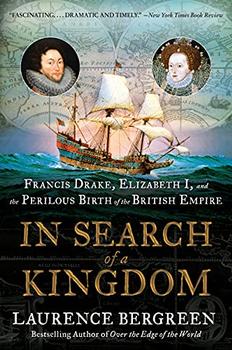Summary | Excerpt | Reviews | Beyond the Book | Readalikes | Genres & Themes | Author Bio

Francis Drake, Elizabeth I, and the Perilous Birth of the British Empire
by Laurence Bergreen
These were the darkest years for young Elizabeth. During this time, Catherine Parr, Henry's last wife, married Edward VI's uncle, Thomas Seymour of Sudeley. The couple took Elizabeth into their household at Chelsea. There Seymour, nearly forty years old, was said to have sexually harassed Elizabeth, who was only fourteen. Entering her bedroom dressed only in a nightgown, he tickled the girl and smacked her buttocks. Strangely, Catherine Parr participated. She, too, tickled Elizabeth and restrained the girl as her husband slashed her gown "into a thousand pieces." But when Catherine discovered her husband embracing Elizabeth, she put a stop to the outlandish behavior. In May 1548, she moved Elizabeth out of the household.
It has been theorized that these episodes had a formative effect on Elizabeth's character. The victims of sexual abuse can manifest an unusual interest in or avoidance of sexual activity. They can suffer from sleeplessness, or nightmares, or other symptoms of what is now called post-traumatic stress disorder. Elizabeth experienced all of these symptoms throughout her life.
On Henry's death, his young son, Edward, ascended to the throne. England's first Protestant monarch was plagued by a series of debilitating illnesses, and he died in 1553, just fifteen years old. Edward's untimely death precipitated another succession crisis. Edward's Protestant cousin, Jane Grey, highly educated, and herself only sixteen years old, briefly succeeded him. While Lady Jane was awaiting coronation, Edward's oldest sister, Mary, a Catholic, and Henry VIII's daughter with his first wife, orchestrated the trial and execution of both Jane Grey and her husband for treason.
Mary ascended to the throne in 1553 and plotted to return England and Ireland to the Roman Catholic Church. During her five-year-long reign of terror, Mary ordered 280 dissenters burned at the stake. Protestants denounced her as "Bloody Mary." She relished her role as an avenging angel but worried that her much younger half sister, Elizabeth, would spark a Protestant insurrection. To prevent that circumstance, Mary confined Elizabeth to the Tower of London, a medieval fortress and prison rising above the north bank of the Thames.
Determined to prevent Elizabeth from succeeding her, Mary married Prince Philip II of Spain and hoped for an heir. In September 1554, she began to gain weight, stopped menstruating, and developed nausea. It seemed an heir was on the way. Only Philip had doubts. Elizabeth, languishing under house arrest, was summoned to observe the birth of Mary's successor, but Mary had suffered a false pregnancy. She considered the outcome divine retribution for having "tolerated heretics" in her realm. After another false pregnancy, she died on November 17, 1558, possibly of ovarian cancer.
Despite Mary's machinations, Henry VIII's second child, Elizabeth Tudor, age twenty-five, became queen, a Protestant monarch. Her hold on power was tenuous, and few had any inkling that she was destined for greatness on the throne as she did her best to juggle the competing claims of Protestants and Catholics.
Excerpted from In Search of a Kingdom by Laurence Bergreen. Copyright © 2021 by Laurence Bergreen. Excerpted by permission of Custom House. All rights reserved. No part of this excerpt may be reproduced or reprinted without permission in writing from the publisher.
Too often we enjoy the comfort of opinion without the discomfort of thought.
Click Here to find out who said this, as well as discovering other famous literary quotes!
Your guide toexceptional books
BookBrowse seeks out and recommends the best in contemporary fiction and nonfiction—books that not only engage and entertain but also deepen our understanding of ourselves and the world around us.